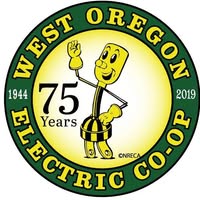Our Story
Imagine a life without electricity or natural gas. No A/C to keep you cool in the summer. No heat to warm your family in the winter. No stove, no refrigerator, no lights, no internet.
For thousands of Oregon families, this scenario is all too real. A medical emergency or loss of income can quickly snowball into a financial crisis, leaving families with mounting debt and agonizing decisions. Buy food or pay the electric bill? Give up light, or sacrifice medicine? Rent or the gas bill? We believe no one should face these questions.
The Oregon Energy Fund is a 35-year-old nonprofit that provides energy bill assistance to low-income Oregonians in support of household stability. Since 1989, OEF has helped over 350,000 people pay their bills in times of crisis, ensuring that families in need don’t have to sacrifice food, rent, or medicine to pay for electricity. Through the direct service of energy assistance, we supply a basic need that prevents the triple traumas of illness, homelessness, and hunger, and gives children and adults alike the support they need to lead healthy and productive lives.
Frequently Asked Questions
How many people need help paying their utility bills?
Nearly 1 in 3 Americans nationwide struggle to pay their energy bills each year, while 1 in 5 cut back on necessities like food, rent, or medicine to make ends meet, according to studies by the Energy Information Administration, the Federal Reserve Board, and the Oregon Department of Energy. Here in Oregon, around 1 in 4 households, or 433,000 homes, struggled to pay their bills in 2018 – twice the number of families who face food insecurity – with the lowest-income families devoting up to 40% of their income to energy alone.
In fact, a recent survey of low-income families in Washington County found that utility hardship affected more people than any other issue, including unemployment and falling behind on the rent, and that energy assistance was the most-desired resource that would help most respondents feel stable and secure.
Why is utility hardship so important?
While we often think of electricity as a convenience, rather than a basic need, losing power can have devastating consequences. Energy is vital for storing food and preparing meals, for sanitation, and as a refuge against extreme temperatures. Countless Oregonians rely on electricity for in-home medical needs, like refrigerating insulin and powering oxygen machines. Other studies have found that as utility hardship increases, so does food insecurity, leading to childhood malnutrition and other developmental deficiencies.
Families who suffer from utility hardship are at increased risk for serious health problems, including pneumonia, heart disease, rheumatism, depression, and diabetes, and “can experience increased economic hardship and difficulty in moving out of poverty,” according to the American Council for an Energy-Efficient Economy (ACEEE). And nearly 25% of respondents to the 2018 National Energy Assistance Survey reported becoming homeless or having to move in with friends or family because of their energy bills.
What are the benefits of energy assistance?
Energy bill assistance, a relatively minor expense, can lead to major, positive changes that reverberate throughout a community. For example, a 2006 study by the American Academy of Pediatrics found that children in low-income families were less likely to experience undernutrition when their families received energy assistance – since those families didn’t have to choose between buying food and paying the bills.
In a recent national survey, 39% of respondents said their electricity would have been disconnected if they hadn’t received energy assistance. 54% said they would’ve kept their homes at an unsafe or unhealthy temperature to keep their bills down.
Utility hardship is most often felt by a community’s most vulnerable populations. A 2016 ACEEE study found that households that identify as low-income, African American, Latinx, or Native are more likely to be energy burdened and face a higher energy burden than the average household. Households in rural communities are also more likely to be energy burdened, which can lead to a chilling effect on local economies, since families have less disposable income to spend. Energy assistance can offset these unequal burdens.
In short, reducing a family’s energy burden through energy assistance leads to greater household stability and a healthier community in general – especially among vulnerable or marginalized populations.
How does the Oregon Energy Fund help?
OEF is Oregon’s leading energy assistance nonprofit, with programs in all 36 counties. We partner with a statewide network of community agencies and local utility companies to distribute funds to Oregonians in need. In 2024, we helped more than 4,941 people in 2,155 households pay their gas, electric, and energy bills – including 1,586children, 828 seniors, and 708 disabled/differently-abled individuals.
Are there other organizations that provide utility bill assistance?
Oregon Energy Fund is the only statewide nonprofit dedicated specifically to the issue of utility hardship. Some churches and local community action organizations have small allocations for energy assistance, but not enough resources exist.
How are you different from LIHEAP or OEAP?
The Low-Income Home Energy Assistance Program (LIHEAP) and Oregon Energy Assistance Program (OEAP) are federal and state initiatives that provide long-term energy assistance to low-income households. However, these programs only have enough funds to help about 20% of eligible Oregon households, leaving hundreds of thousands of potential recipients without aid.
Moreover, while LIHEAP & OEAP are limited to low-income households, utility hardship is not. According to the Federal Reserve Board, 40% of all American adults are unable to pay for an unexpected $400 expense, such as a medical visit, car problems, or a layoff. Households faced with such a bill are often forced to siphon money away from monthly expenses like food and utility payments, which can have a snowball effect.
While one-time energy bill assistance would neutralize this problem, many of these households have a moderately higher income and thus do not qualify for federal or state aid. Oregon Energy Fund’s income guidelines are specifically structured to include Oregonians with slightly higher incomes, which also prevents the need for long-term assistance. We are the only organization in the state to address this funding gap.
How can I help?
As a 501(c)3 nonprofit, our work depends almost exclusively on the support of our friends, neighbors, and community. Please consider making a one-time or monthly donation to our energy assistance programs.
Financial Disclosures
Print copies of the following financial disclosures and the Annual Report are available upon request.
Meet Our Team
Board of Directors
- Sarah Simmons, President
- R/West
- Jordan Schoonover, Vice President
- McDowell Rackner Gibson PC
- Paul Koehler, Secretary
- Pelican Renewables
- Katherine Estrada, Treasurer
- U.S. Bank
- Saul Chavez-Hernandez
- Portland General Electric
- David DiMatteo
- Upstream USA
- Bob Gravely
- Pacific Power
- Billi Kohler
- West Oregon Electric
- Eloisa Mariscal
- Community Action
- Darcy Noxon
- NW Natural Gas
- Charity Spires
- Pacific Power
- Anne Wahr
- Portland General Electric
- Tori Bryson, Immediate Past President
- Hoffman, Stewart & Schmidt, P.C.
Staff
- Brian Allbritton
- Executive Director
- Marietta Doney
- Deputy Director
- Kevin Brown
- Development Director
- Victoria Unger
- Accounting Assistant/Finance Coordinator
- Halaina Bladey
- Office Coordinator
- Daniel Boiciuc
- Office Coordinator




